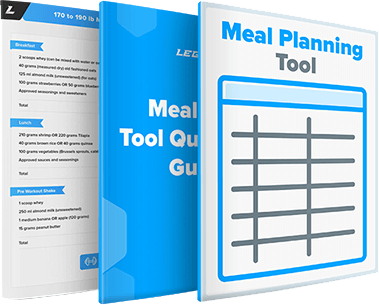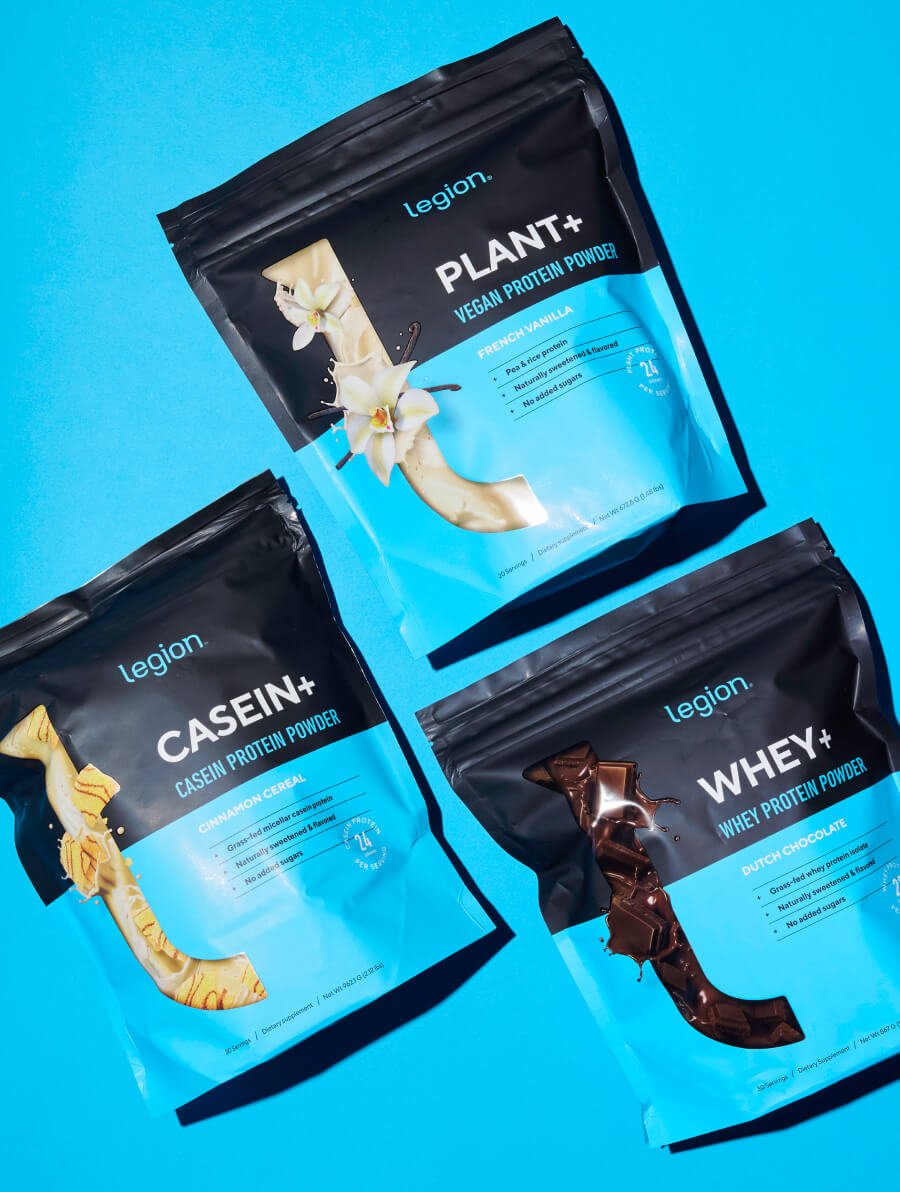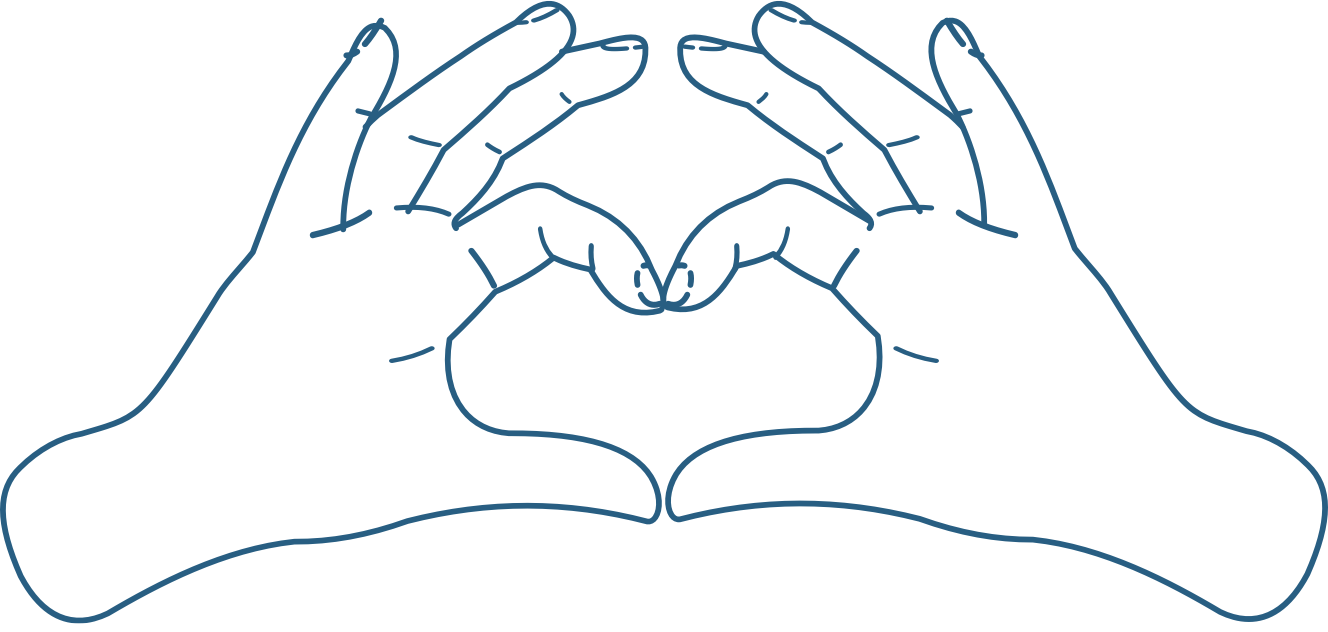“Skinny fat” refers to a body composition where someone appears slim in clothes but soft or flabby without them because they have too little muscle and too much body fat.
It’s most often caused by not lifting weights, but eating too little protein, undereating calories, or doing excessive cardio can all make it worse.
In this article, you’ll learn exactly what skinny fat means, how to tell if it applies to you, and how to fix it in five simple steps.
Want to know exactly how you should train to reach your fitness goals? Take our free 60-second training quiz and find out now.
Key Takeaways
- If you look slim in clothes but soft or flabby without them, you might be “skinny fat”—a result of having too little muscle and too much fat.
- The most common causes are not lifting weights, eating too little protein, undereating calories, and doing too much cardio.
- The best fix for skinny fatness is building muscle with heavy, compound weightlifting, eating enough protein, and avoiding crash dieting.
- Beginners can build muscle and lose fat at the same time. Everyone else should build muscle first, then cut fat.
- To get rid of skinny fat as quickly as possible, consider using a high-quality protein powder, creatine, and pre-workout. These supplements boost performance, support recovery, and make it easier to hit your daily protein target.
Table of Contents
+
What Is Skinny Fat?

Skinny fat describes a body composition where someone has a normal body weight but has little muscle and carries excess fat, particularly around the belly, chest, and hips. They often appear lean in clothes but look untoned when undressed.
That’s the everyday definition, at least. But there’s also a more scientific one.
In research, skinny fatness is known by many names, including “normal weight obesity,” “metabolic obesity,” “metabolically unhealthy non-obese,” or the “thin fat phenotype.”
These terms refer to people who have a normal body mass index (BMI) but an unhealthy amount of body fat, which increases their risk of all-cause mortality and conditions like insulin resistance and heart disease.
What Does Skinny Fat Look Like?
Skinny fatness looks a little different for everyone. That said, most skinny fat men look slim overall but carry excess fat in areas like the belly, chest, and lower back, while skinny fat women usually carry extra fat around their hips, thighs, and stomach.
One constant in both sexes is having little or no muscle definition.
Even if your body fat percentage is within a healthy range, lacking muscle can make your body look soft, flat, or doughy rather than lean and athletic. You can see this clearly in the comparison below:
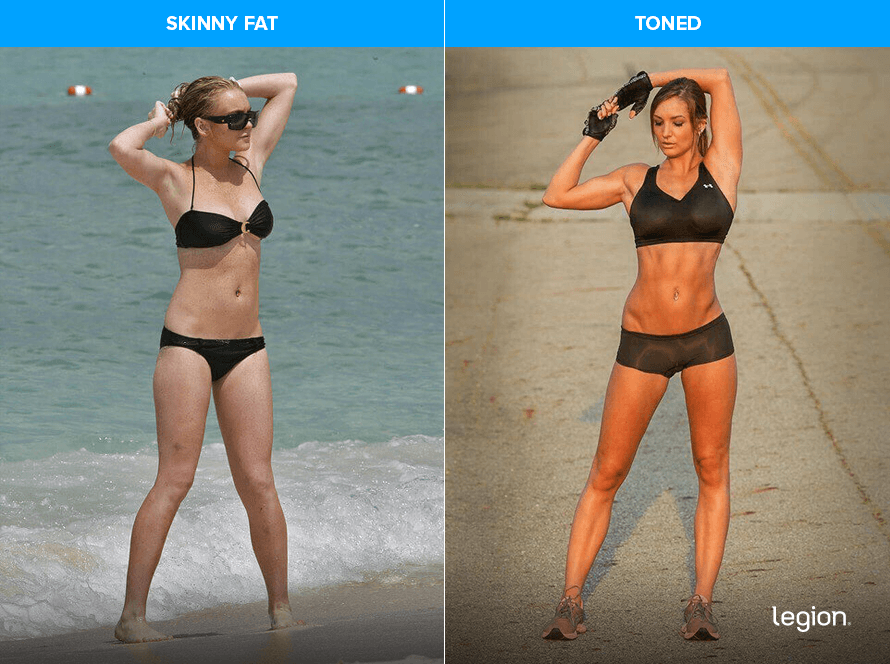
Both women have similar levels of body fat, but the one on the right looks noticeably fitter—not because she’s leaner, but because she has more muscle. The woman on the left is slim, but her lack of muscle makes her look less defined.
This illustrates an important point: The less muscle you have, the more prone you are to looking skinny fat, even at a healthy weight. An extremely under-muscled guy at 15% body fat can look skinny fat whereas a muscular guy at the same level of body fat can look impressive.
Skinny Fat Examples
Here are more examples of what the skinny fat body type looks like in men and women:
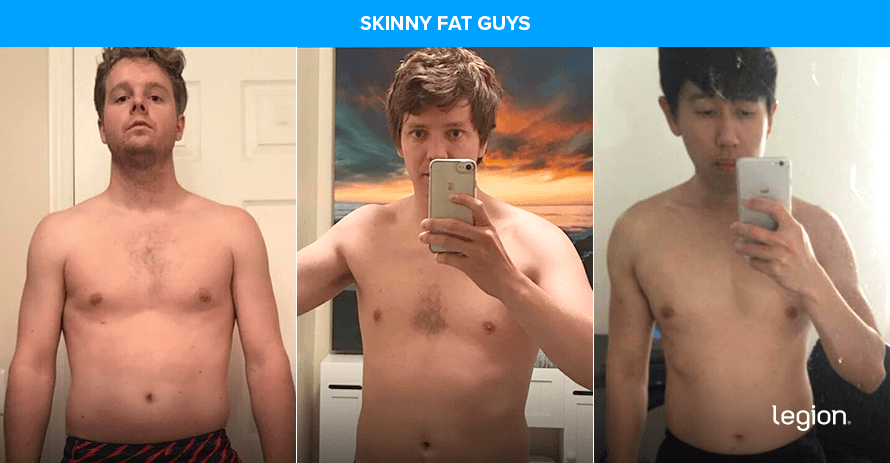
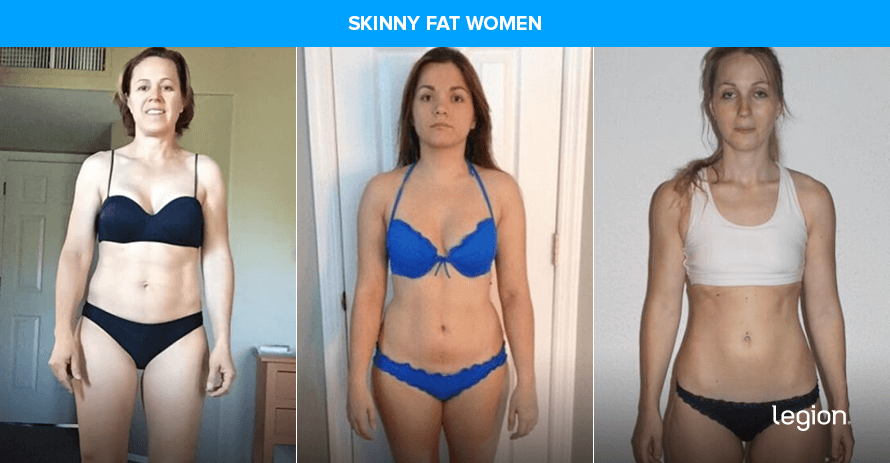
As you can see, these people don’t necessarily look unhealthy, but they also don’t look particularly fit. That’s because body composition—not just body weight—determines how athletic and healthy you appear.
What Causes Skinny Fat?
The four main causes of a skinny fat body type are:
- Doing little or no strength training: If you don’t lift weights regularly, your body has no reason to build or maintain significant amounts of muscle. Over time, you end up with a soft, underdeveloped physique, even if you’re lean.
- Eating too little protein: Protein is what your body uses to build and maintain muscle. If you don’t get enough, it’s impossible to gain significant size. It also helps keep you full, so eating too little protein can make it harder to stay lean, too.
- Severely restricting calories: Crash dieting can result in rapid muscle loss, especially when you aren’t lifting weights, which is one of the fastest ways to become skinny fat.
- Doing excessive cardio: Too much cardio can interfere with muscle growth and accelerate muscle loss—particularly when you pair it with low-protein, low-calorie dieting.
The good news is that all of this is fixable. Here’s how.
How to Get Rid of Skinny Fat in 5 Simple Steps
The best way to fix a skinny fat body is to build muscle first, then lose excess fat. Doing things in this order has the greatest impact on your appearance and health.
Here are a few people who joined Legion’s body transformation coaching program. They followed this advice, and their skinny fat transformations speak for themselves:
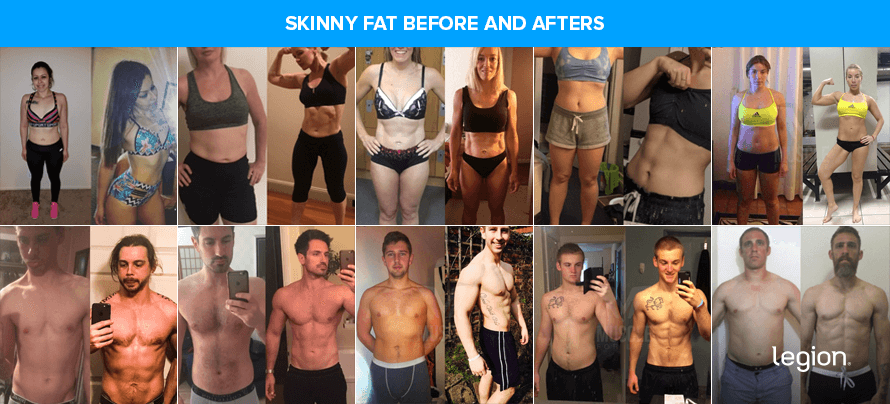
There’s only one exception: if you’re new to proper weightlifting, you can build muscle and lose fat at the same time. So if you’re a beginner, focus on losing fat first, as you’ll still be able to build a respectable amount of muscle while dieting.
Whether you start by bulking or cutting, the following five steps will help you get rid of skinny fat for good.
1. Focus on Strength Training
Doing just 2–3 strength training workouts per week is enough to visibly reduce skinny fatness, and 4–5 workouts per week is optimal.
That’s all it takes to build and preserve muscle mass, which is the most effective way to fix a skinny fat body.
Heavy, compound exercises like squats, deadlifts, presses, and rows are your golden ticket. Even if you mess up every other part of this plan, consistent weightlifting will still help you gain muscle and look more defined.
If you’d like specific advice about which training program you should follow to reach your health and fitness goals, take the Legion Strength Training Quiz, and in less than a minute, you’ll know the perfect strength training program for you. Click here to check it out.
2. Eat More Protein
As a rule of thumb, eat 0.8–1 gram of protein per pound of body weight per day, which works out to around 30–40% of your calories for most people.
That’s enough to give your body the “raw materials” to build and preserve muscle, which is essential for getting rid of the skinny fat look. It may also help you control your hunger, which makes fat loss easier by keeping you full between meals.
3. Eat the Right Number of Calories
If you’re new to weightlifting and can lose fat while building muscle, eat 20–25% fewer calories than you burn daily (a “caloric deficit”).
This supports fast fat loss while still allowing you to gain muscle as a newbie.
If you’re already experienced with weightlifting and want to build muscle before cutting fat, eat 10% more calories than you burn daily (a “calorie surplus”).
Research shows this is enough to fuel muscle growth without causing you to gain excessive fat.
Once you’re happy with how much muscle you have, reduce your calorie intake and cut fat using the same guidelines above.
And if you’d like even more specific advice about how many calories, how much of each macronutrient, and which foods you should eat to reach your health and fitness goals, take the Legion Diet Quiz.
4. Do a Moderate Amount of Cardio
As a rule of thumb, 2–3 cardio sessions per week is plenty for most people trying to fix a skinny fat body.
Cardio can help you stay healthy and lean, but too much—especially when combined with a low-calorie, low-protein diet—can accelerate muscle loss and make skinny fatness worse.
That’s why the aim is to do just enough to support your overall health and fat loss goals, but not so much that it interferes with your strength training or recovery.
5. Take the Right Supplements
Supplements aren’t essential for getting rid of skinny fat, but the right ones can help you train harder, recover faster, and get better results from your workouts. Here are three worth considering:
- Protein powder: Protein powder, such as whey or casein, provides your body with the nutrients needed to build muscle tissue and recover from workouts. For a clean and delicious protein powder, try Whey+ or Casein+.
- Creatine: Creatine boosts muscle and strength gain, improves anaerobic endurance, and reduces muscle damage and soreness from your workouts. For a natural source of creatine, try our creatine monohydrate, creatine gummies, or Recharge,
- Pre-workout: A high-quality pre-workout enhances energy, mood, and focus, increases strength and endurance, and reduces fatigue. For a top-tier pre-workout containing clinically effective doses of 6 science-backed ingredients, try Pulse with caffeine or without.
(If you’d like even more specific advice about which supplements you should take to reach your health and fitness goals, take the Legion Supplement Finder Quiz, and in less than a minute, you’ll know exactly what supplements are right for you.)
Is Having a Skinny Fat Body Type Unhealthy?
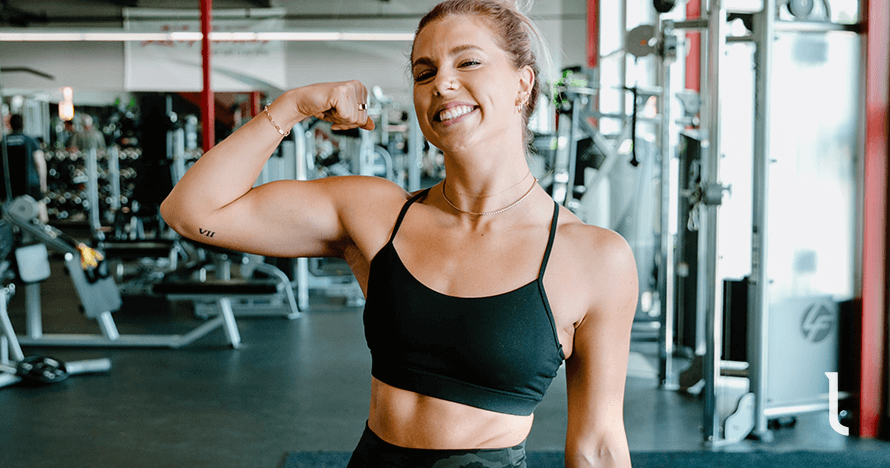
Being “skinny fat” doesn’t automatically mean you’re unhealthy, but you could likely improve your health and lower disease risk by losing fat and gaining muscle.
While many believe a “healthy” BMI indicates good health, it doesn’t account for body composition. You can have a healthy BMI but still carry an unhealthy amount of fat.
Research even suggests that it’s possible to be “metabolically obese” at a normal weight, which increases risks like insulin resistance, high cholesterol, and high blood pressure. This is especially true if you have a lot of visceral fat (fat around your internal organs, not to be confused with fat under your skin, called subcutaneous fat), which is associated with many diseases and an early death. And in many cases, these people are also skinny fat.
Not every skinny fat person will have these health problems, but keeping body fat in check is crucial for reducing disease risk. Equally important from a health and longevity perspective is building and maintaining muscle mass.
A study from the University of California showed that individuals with both high body fat and muscle mass had a lower risk of dying from heart disease compared to those with low body fat and muscle mass.
In other words, having more muscle (even with some fat) could be healthier than being skinny fat. Other studies also show that those with more muscle mass have a reduced risk of diabetes and cancer, and a higher overall quality of life.
FAQ #1: How can I tell if I’m skinny fat?
If you’re a guy with 10–20% body fat or a woman with 20–30%, you’re not naturally muscular, and you haven’t done much (or any) strength training in the past year, you’re probably skinny fat.
That said, there’s no precise definition, and unless you’re a metabolically obese, normal-weight person, it’s primarily a subjective determination based on how you look.
FAQ #2: How long does it take to go from skinny fat to fit?
Most people can go from skinny fat to fit in 3–6 months by following a proper strength training program, eating enough protein, and adjusting their calorie intake based on their goals.
That said, it mostly depends on how skinny fat you are and how quickly you lose fat and build muscle.
FAQ #3: Should I do cardio if I have a skinny fat body type?
Yes, but don’t overdo it. Cardio won’t make you skinny fat on its own—but doing too much, especially alongside a low-protein, low-calorie diet, can speed up muscle loss.
If you follow the guidelines in this article, however, cardio can actually support your fat loss and health goals. A good rule of thumb is to do 2–3 moderate-intensity cardio workouts per week.
Scientific References +
- Kapoor, Nitin. “Thin Fat Obesity: The Tropical Phenotype of Obesity.” PubMed, MDText.com, Inc., 2021, www.ncbi.nlm.nih.gov/books/NBK568563/.
- Wan, Jindong, et al. “Impact of Normal Weight Central Obesity on Clinical Outcomes in Male Patients with Premature Acute Coronary Syndrome.” Angiology, vol. 70, no. 10, 14 Mar. 2019, pp. 960–968, https://doi.org/10.1177/0003319719835637. Accessed 3 Jan. 2023.
- Ballor, D L, et al. “Resistance Weight Training during Caloric Restriction Enhances Lean Body Weight Maintenance.” The American Journal of Clinical Nutrition, vol. 47, no. 1, 1 Jan. 1988, pp. 19–25, academic.oup.com/ajcn/article/47/1/19/4694815, https://doi.org/10.1093/ajcn/47.1.19.
- Helms, Eric R, et al. “Evidence-Based Recommendations for Natural Bodybuilding Contest Preparation: Nutrition and Supplementation.” Journal of the International Society of Sports Nutrition, vol. 11, no. 1, 12 May 2014, www.ncbi.nlm.nih.gov/pmc/articles/PMC4033492/, https://doi.org/10.1186/1550-2783-11-20.
- Soenen, Stijn, and Margriet S Westerterp-Plantenga. “Proteins and Satiety: Implications for Weight Management.” Current Opinion in Clinical Nutrition and Metabolic Care, vol. 11, no. 6, Nov. 2008, pp. 747–751, https://doi.org/10.1097/mco.0b013e328311a8c4.
- Iraki, Juma, et al. “Nutrition Recommendations for Bodybuilders in the Off-Season: A Narrative Review.” Sports, vol. 7, no. 7, 26 June 2019, p. 154, www.ncbi.nlm.nih.gov/pmc/articles/PMC6680710/, https://doi.org/10.3390/sports7070154.
- Stokes, Tanner, et al. “Recent Perspectives Regarding the Role of Dietary Protein for the Promotion of Muscle Hypertrophy with Resistance Exercise Training.” Nutrients, vol. 10, no. 2, 7 Feb. 2018, p. 180, www.mdpi.com/2072-6643/10/2/180/pdf.
- Eckerson, Joan M., et al. “Effect of Creatine Phosphate Supplementation on Anaerobic Working Capacity and Body Weight after Two and Six Days of Loading in Men and Women.” The Journal of Strength and Conditioning Research, vol. 19, no. 4, 2005, p. 756, https://doi.org/10.1519/r-16924.1.
- Bassit, Reinaldo Abunasser, et al. “Effect of Short-Term Creatine Supplementation on Markers of Skeletal Muscle Damage after Strenuous Contractile Activity.” European Journal of Applied Physiology, vol. 108, no. 5, 3 Dec. 2009, pp. 945–955, https://doi.org/10.1007/s00421-009-1305-1.
- Ding, Cherlyn, et al. “Lean, but Not Healthy.” Current Opinion in Clinical Nutrition and Metabolic Care, vol. 19, no. 6, Nov. 2016, pp. 408–417, https://doi.org/10.1097/mco.0000000000000317.
- Sahakyan, Karine R., et al. “Normal-Weight Central Obesity: Implications for Total and Cardiovascular Mortality.” Annals of Internal Medicine, vol. 163, no. 11, 10 Nov. 2015, p. 827, annals.org/aim/article-abstract/2468805/normal-weight-central-obesity-implications-total-cardiovascular-mortality?resultClick=3, https://doi.org/10.7326/M14-2525.
- Srikanthan, Preethi, et al. “Relation of Muscle Mass and Fat Mass to Cardiovascular Disease Mortality.” American Journal of Cardiology, vol. 117, no. 8, 15 Apr. 2016, pp. 1355–1360, www.ajconline.org/article/S0002-9149(16)30155-2/fulltext, https://doi.org/10.1016/j.amjcard.2016.01.033.
- Haraldstad, Kristin, et al. “Changes in Health-Related Quality of Life in Elderly Men after 12 Weeks of Strength Training.” European Review of Aging and Physical Activity, vol. 14, no. 1, 30 May 2017, https://doi.org/10.1186/s11556-017-0177-3.
- Rizzoli, René, et al. “Quality of Life in Sarcopenia and Frailty.” Calcified Tissue International, vol. 93, no. 2, 5 July 2013, pp. 101–120, https://doi.org/10.1007/s00223-013-9758-y.
- Caan, Bette J., et al. “The Importance of Body Composition in Explaining the Overweight Paradox in Cancer—Counterpoint.” Cancer Research, vol. 78, no. 8, 15 Apr. 2018, pp. 1906–1912, cancerres.aacrjournals.org/content/78/8/1906.short, https://doi.org/10.1158/0008-5472.CAN-17-3287.
- Srikanthan, Preethi, and Arun S. Karlamangla. “Relative Muscle Mass Is Inversely Associated with Insulin Resistance and Prediabetes. Findings from the Third National Health and Nutrition Examination Survey.” The Journal of Clinical Endocrinology & Metabolism, vol. 96, no. 9, Sept. 2011, pp. 2898–2903, https://doi.org/10.1210/jc.2011-0435.
